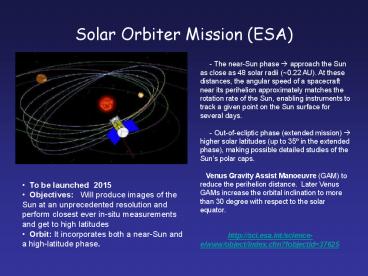Solar Orbiter Mission (ESA) - PowerPoint PPT Presentation
Title:
Solar Orbiter Mission (ESA)
Description:
... resolution and perform closest ever in-situ measurements and get to high latitudes. Orbit: It incorporates both a near-Sun and ... High Resolution Telescope ... – PowerPoint PPT presentation
Number of Views:185
Avg rating:3.0/5.0
Title: Solar Orbiter Mission (ESA)
1
Solar Orbiter Mission (ESA)
- - The near-Sun phase ? approach the Sun as
close as 48 solar radii (0.22 AU). At these
distances, the angular speed of a spacecraft near
its perihelion approximately matches the rotation
rate of the Sun, enabling instruments to track a
given point on the Sun surface for several days. - - Out-of-ecliptic phase (extended mission) ?
higher solar latitudes (up to 35º in the
extended phase), making possible detailed studies
of the Suns polar caps. - Venus Gravity Assist Manoeuvre (GAM) to
reduce the perihelion distance. Later Venus GAMs
increase the orbital inclination to more than 30
degree with respect to the solar equator. - http//sci.esa.int/science-e/www/obj
ect/index.cfm?fobjectid37625
- To be launched 2015
- Objectives Will produce images of the Sun at
an unprecedented resolution and perform closest
ever in-situ measurements and get to high
latitudes - Orbit It incorporates both a near-Sun and a
high-latitude phase.
2
The Second Solar Orbiter workshop goals
- Inform the wider community of the SolO
opportunity and to investigate synergies to
enhance the opportunity, including ground-based
support and modelling. - Discuss Solar Orbiter operations strategies and
scenarios, and outline how the goals of Orbiter
will be achieved. - Strengthen the political and scientific support
for the mission, demonstrating the wide
international interest in the mission. - Improve the definition of the payload
scientifically andtechnologically. - Identify ways of mission optimization and
international cooperation.
3
Visible-Light Imager and Magnetograph (VIM)
- Full Magnetic Vector, Continuum and Velocity
Images. - Spectral line Fe I 6173A
- 2048x2048 detector
- Two telescopes
- High Resolution Telescope
- Full Disk Telescope FOV of 2.6 degrees and a
pixel size of 730Km at 0.22 AU (GONG 1.5Mm) - At high latitudes ? Short observation periods
of 10-30 days
4
Solar Sentinels (NASA)
- Inner Heliospheric Sentinels--four identical
probes stationed inside the orbits of Venus and
Mercury. These spacecraft would sample freshly
accelerated solar energetic particles close to
the Sun. - The four Inner Heliospheric Sentinels will
face unique thermal and power challenges as they
orbit the Sun, some well inside Mercury's orbit. - Near-Earth Sentinela single probe orbiting
Earth. This Sentinel would carry a coronagraph, a
special telescope for observing the Sun's faint
corona where CMEs get their start. - Farside Sentinela single probe to watch the
farside of the sun. Together with other
spacecraft, this sentinel would provide a
complete picture of the Sun--not just the half we
see from Earth.
5
Solar Orbiter / Solar Sentinels
- Some Advantages
- Reduce the cost
- Increase the probability of both missions to
actually happen. - Increase scientific opportunities
- Remote sensing capability of SoLO will enhance
IHS science - Combined ESA/NASA ground stations improve SoLO
data rate and cadence. - Some Disadvantages
- Reduce the proximity to the Sun for SoLO, and max
inclination - Suggestion of reduce from 4 to 3 IHS
- Redundancy of some instruments (?)
- Weight load.
6
Solar Orbiter the orbit
7
Solar Orbiter the orbit































